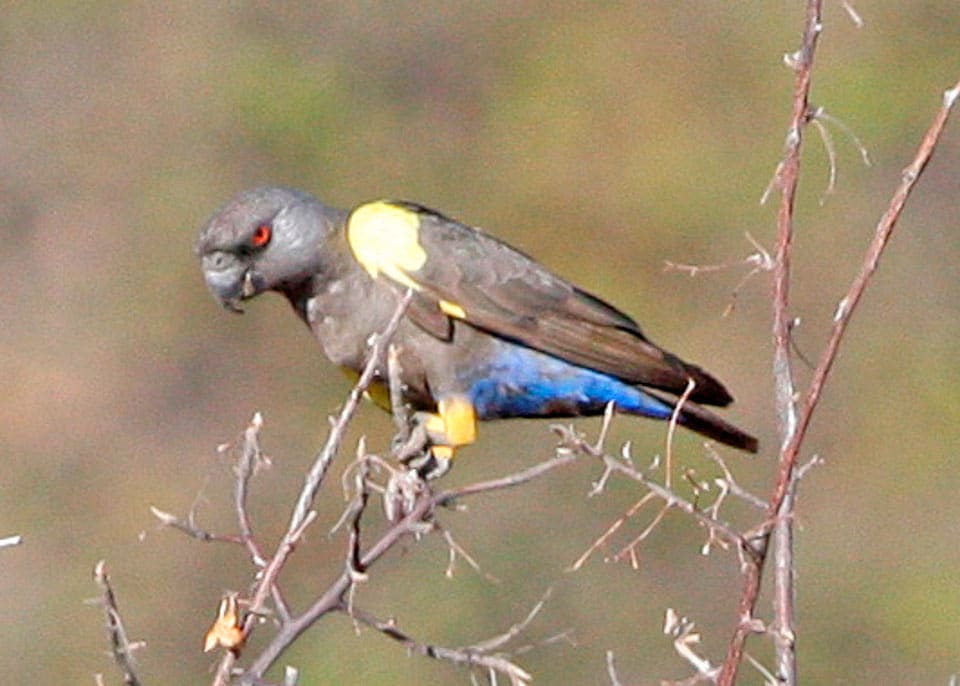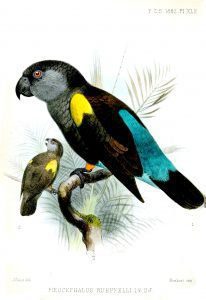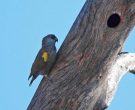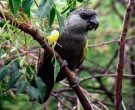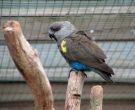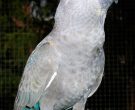Content |
|---|
Description:
22 cm.. length and a weight between 105 and 132 g..
The Rüppell's parrot (Poicephalus rueppellii) has the head, generally, dark brown, clearer in the sides of the face with ear-coverts Silver. Nape, the mantle and scapulars brown in color with slightly paler silver tips and rather diffused on most feathers (especially in the nape); rump brown with blue wash, occasionally feathers Bright blue. Upper, the under wing-coverts brown. Leading Edge wing , Since the carpal joints at the base of the primaries bright yellow. The primaries and secondaries brown above, paler below. Wing feathers bright yellow.
The underparts, above all, uniformly brown, clearly lighter than the upperparts; the thighs bright yellow; undertail- coverts and posterior flanks with blue wash, sometimes a few feathers with bright blue tips. Tail darker brown than the rest of the plumage.
Bill greyish black; cere black; irises orange-red; perioftalmico ring black ; legs black.
The females They have lower back, rump, uppertail-coverts, lower abdomen, undertail- coverts and the back of the flanks bright blue..
The immature They are similar to females but duller blue and less extensive, lighter brown in the body, the thighs brown. Wing feathers and set carpiano yellowish brown brown; clear margins in the wing-coverts.
- Sound of the Rüppell's parrot.
Habitat:
They live in forests along water courses dry, dry forests (including forests Euphorbia), dry steppe thorny veld, showing a preference for areas with Adansonia or other tall trees; also in formations Acacia / Commiphora in Escarpment Namibia. Not registered above 1.250 metres in Angola.
Usually they found near water, in small flocks (until 20 birds); sometimes in greater numbers when food is plentiful.
Reproduction:
The nest usually it located in the old hole of a carpenter, at a height of up to 5 meters above the ground. It is believed that usually they breed from the months of February to May, but juvenile birds have been observed in September: the breeding It may be more closely linked to precipitation of the season. Of 3 to 5 egg white, rounded form the usual commissioning.
Food:
They feed yolks, outbreaks, nectar, flowers, seeds, guilt, etc… (the endocarpio It is believed to be very important in your diet), of the Acacia karoo, A. erubescens, Prosopis juliflora, Faidherbia whitish, Terminalia prunoides, Combretum beardless, Grewia, Loniceroides, Ficus and melons; insect larvae They have also been registered in your diet.
The Rüppell's parrot quake, normally, morning and afternoon.
Distribution:
Size of the area of distribution (reproduction / resident): 940.000 km2
Distributed by Southwest Africa, from the southwest of Angola (Luanda) to Damaraland, West of Ovamboland and North of Namaqualand (region Rehoboth), in the North of Namibia.
Some local nomadic movements in relation to the food supply, otherwise residents. Usually they reported as locally common but fluctuations can occur with nomadic movements.
Conservation:
• Current IUCN Red List: Least concern
• Population trend: Decreasing
The size of the world's population has not been quantified, although it is estimated below 30.000 individuals.
The species according to information, It quite common within suitable habitat.
The population is suspected of being in decline due to unsustainable levels of exploitation. Also their population numbers are threatened by the cage bird trade – an estimated number between 600 and 1000 birds are exported annually to South Africa and Europe, approximately 60-70% of them die during transport.
"Rüppell's parrot" in captivity:
Very rare in captivity.
Take it easy, It is a species in which males seem to speak better than females, usually they have easy to mimic sounds of other birds.
In terms of their longevity, according to sources, a specimen lived 34,3 years in captivity.
Alternative names:
– Rueppell’s Parrot, Ruppell’s Parrot, Rüppell’s Parrot (English).
– Perroquet de Rüppell (French).
– Rüppellpapagei, Rüppell Papagei, Rüppell-Papagei (German).
– Papagaio de Rüppell, Papagaio-de-rüppell (Portuguese).
– Lorito de Ruppell, Lorito de Rüppell (español).
scientific classification:
– Order: Psittaciformes
– Family: Psittacidae
– Genus: Poicephalus
– Scientific name: Poicephalus rueppellii
– Citation: (Gray, GR, 1849)
– Protonimo: Psittacus Rüppelii
Images “Rüppell's parrot”:
Videos "Rüppell's parrot"
————————————————————————————————
“Rüppell's parrot” (Poicephalus rueppellii)
Sources:
– Avibase
– Parrots of the World – Forshaw Joseph M
– Parrots A Guide to the Parrots of the World – Tony Juniper & Mike Parr
– Birdlife
– Photos:
(1) – An adult female Rüppell’s Parrot near Hobatere Lodge, Kamanjab, Namibia By Ron Knight from Seaford, East Sussex, United Kingdom (Ruppell’s ParrotUploaded by snowmanradio) [CC BY 2.0], via Wikimedia Commons
(2) – In captivity by Udo Berg –> Heggy – Wikipedia
(3) – Rüppel's parrot – papageien.org
(4) – Poicephalus rueppellii rueppells parrot – Birds-pet-wallpapers
(5) – Poicephalus rueppellii in Erongo Mountains, Namibia – Buckham Birding
(6) – Proceedings of the Zoological Society of London 1882 by Joseph Smit [Public domain], via Wikimedia Commons
– Sounds: Charles Hesse (Xeno-canto)
